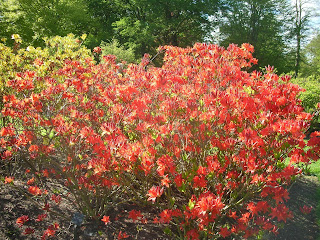Royal Botanic Gardens, Kew (which is what it's officially called) covers over 300 hundred acres and now possesses approximately 1/10 of known plant species within its seed library. You can find plants here that are nearly extinct. Kew isn't just a lot of pretty plants; it's also a research facility that tries to preserve as many plants from extinction as possible, figuring out how they grow in order to keep them alive. Species of plants go extinct every day and part of the responsibility they have taken upon themselves is to prevent that from happening, as much as they can.
 This is a view from the promenade when you walk in. The green house you see is the tropical green house (there are internal photos later). The architect wanted to build something original, something he would be known for, so he did a few things that almost nobody did in the Victorian era: he used curved glass panes and wrought iron (as a support structure, which nobody had done because they weren't sure how well it would hold). He also wanted to provide the maximum amount of internal space without a lot of support beams getting in the way. The designer who helped him was essentially a ship designer and so was used to providing a maximum amount of storage space. Basically, they ended up making an upside down ship, which you can see better in another picture of it.
This is a view from the promenade when you walk in. The green house you see is the tropical green house (there are internal photos later). The architect wanted to build something original, something he would be known for, so he did a few things that almost nobody did in the Victorian era: he used curved glass panes and wrought iron (as a support structure, which nobody had done because they weren't sure how well it would hold). He also wanted to provide the maximum amount of internal space without a lot of support beams getting in the way. The designer who helped him was essentially a ship designer and so was used to providing a maximum amount of storage space. Basically, they ended up making an upside down ship, which you can see better in another picture of it.  This is a Tulip Tree, one of the oldest ones in Kew Gardens. It's been here since the 1770's.
This is a Tulip Tree, one of the oldest ones in Kew Gardens. It's been here since the 1770's.
 They look a bit brighter here, because of the sun, but this is the colour red that I imagine the rose from Beauty and the Beast being. Not the cartoon version, but the classic, where the father picks a rose from the Beast's garden as a gift for his youngest daughter, and must sacrifice her in his place, as punishment for having stolen the prized rose. Also, I know they're not roses, I just meant the colour.
They look a bit brighter here, because of the sun, but this is the colour red that I imagine the rose from Beauty and the Beast being. Not the cartoon version, but the classic, where the father picks a rose from the Beast's garden as a gift for his youngest daughter, and must sacrifice her in his place, as punishment for having stolen the prized rose. Also, I know they're not roses, I just meant the colour.


 Cacao tree!!! This is where chocolate is born!! Actually, it's quite a long process, where the pulp is taken out of those beans and then there's a bunch of other stuff done to it, but the chocolate we eat is mostly sugar and milk powder. Cacao beans aren't sweet. Never realized they were bright orange before, though.
Cacao tree!!! This is where chocolate is born!! Actually, it's quite a long process, where the pulp is taken out of those beans and then there's a bunch of other stuff done to it, but the chocolate we eat is mostly sugar and milk powder. Cacao beans aren't sweet. Never realized they were bright orange before, though. This plant isn't in bloom just now, but it will be in a week or so. I'm grateful I won't be there when it does. It blooms for approximately forty-eight hours, during which time it gives off the scent of rotting meat, in order to attract insects to pollinate it.
This plant isn't in bloom just now, but it will be in a week or so. I'm grateful I won't be there when it does. It blooms for approximately forty-eight hours, during which time it gives off the scent of rotting meat, in order to attract insects to pollinate it.












































